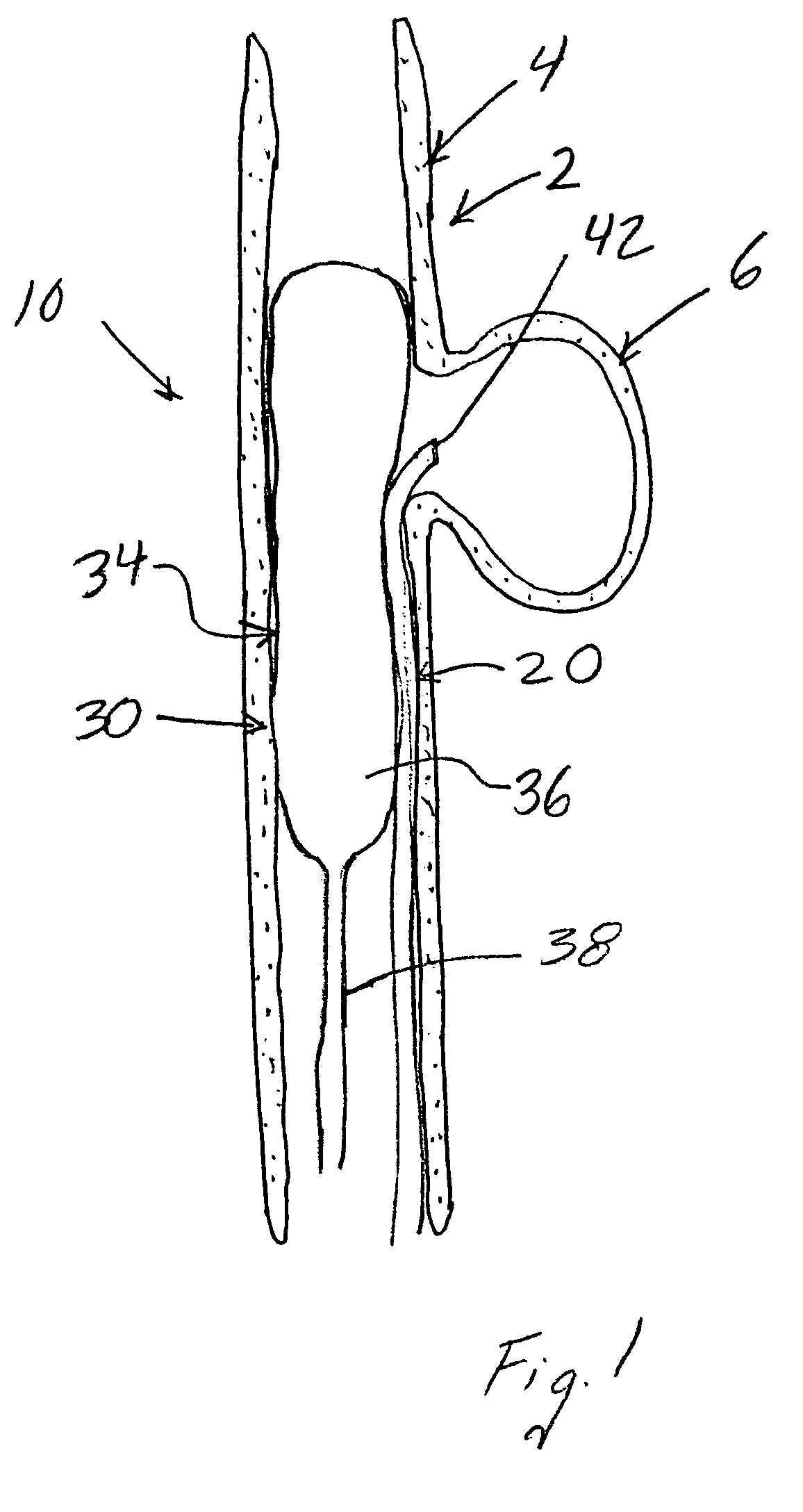Compositions, systems and methods for treatment of defects in blood vessels
a technology of blood vessel and composition, applied in the field of medical treatment methods, can solve the problems of posing a health risk from its potential to rupture, gradual vessel expansion, stroke or other vessel blockage, and eventual death, and achieves the effects of reducing the risk of strok
- Summary
- Abstract
- Description
- Claims
- Application Information
AI Technical Summary
Benefits of technology
Problems solved by technology
Method used
Image
Examples
example 1
Preparation of a Sample Crosslinking Agent, Trimethylol Propane 20 / 3
[0056]Ethoxylated trimethylol propane 20 / 3 (20 g, Aldrich) is dissolved in xylene. The water is removed from the system by azeotropic distillation. Succinic anhydride (8.1 g, Aldrich) and pyridine (100 mL, Aldrich) were added. The reaction is allowed to proceed under reflux overnight. The pyridine and a portion of the xylene were distilled off. The ethoxylated trimethylol propane succinate is removed from the xylene by cooling and collected using a separatory funnel. The ethoxylated trimethylol propane succinate is redissolved in 50 mL of dichloromethane and stored overnight at −20° C. to recrystallize excess succinic anhydride. The crystals were filtered off and dichloromethane is added to prepare a volume of 200 mL. N-hydroxysuccinimide (7.8 g, Aldrich) and diisopropylcarbodimide (10.5 mL, Aldrich) were added sequentially. The reaction is allowed to proceed at room temperature about four hours. The urea is removed...
example 2
Determination of Crosslinking Time
[0057]The crosslinker prepared in accordance with EXAMPLE 1 as well as a variety of other crosslinking agents were synthesized and evaluated to determine their crosslinking time in the laboratory. The crosslinkers evaluated included ethoxylated trimethylol propane 20 / 3 succinimidyl succinate (TMP-SS), ethoxylated pentaerythritol 15 / 4 succinimidyl succinate (PE-SS), 4-arm poly(ethylene glycol) 2k succinimidyl succinate (PEG 2k-SS), 4-arm poly(ethylene glycol) 10k succinimidyl succinate (PEG 10k-SS), and ethoxylated phloroglucinol 30 / 3 succinimidyl succinate (ePG-SS).
[0058]Each crosslinker is dissolved in an appropriate solvent at the desired concentration. Each crosslinker solution (100 microliters) is mixed with 350 microliters of porcine blood treated with EDTA. The crosslinking time, i.e. the time required for the solution to substantially solidify, is determined, and results of the crosslinking time are shown in Table 1 hereinbelow.
[0059]
TABLE 1C...
example 3
Compressive Strength of Crosslinked Mass
[0061]In this example, a variety of crosslinkers are synthesized and evaluated to determine their compressive strength in the laboratory. These crosslinkers include ethoxylated trimethylol propane 20 / 3 succinimidyl succinate (TMP-SS), ethoxylated pentaerythritol 15 / 4 succinimidyl succinate (PE-SS), 4-arm poly(ethylene glycol) 2k succinimidyl succinate (PEG 2k-SS), 4-arm poly(ethylene glycol) 10k succinimidyl succinate (PEG 10k-SS), and ethoxylated phloroglucinol 30 / 3 succinimidyl succinate (ePG-SS).
[0062]Each crosslinker is dissolved in an appropriate solvent at the desired concentration, for example in accordance with EXAMPLE 2 hereinabove. Each crosslinker solution (1 mL) is mixed with 3.5 mL of porcine blood treated with EDTA. The mixture is placed in a 3-cc syringe (Becton Dickinson) and allowed to solidify for about 30 minutes at about 37° C. The Luer fitting is cut off the syringe using a razor blade, and the crosslinked mass is expelled...
PUM
 Login to View More
Login to View More Abstract
Description
Claims
Application Information
 Login to View More
Login to View More - R&D
- Intellectual Property
- Life Sciences
- Materials
- Tech Scout
- Unparalleled Data Quality
- Higher Quality Content
- 60% Fewer Hallucinations
Browse by: Latest US Patents, China's latest patents, Technical Efficacy Thesaurus, Application Domain, Technology Topic, Popular Technical Reports.
© 2025 PatSnap. All rights reserved.Legal|Privacy policy|Modern Slavery Act Transparency Statement|Sitemap|About US| Contact US: help@patsnap.com



